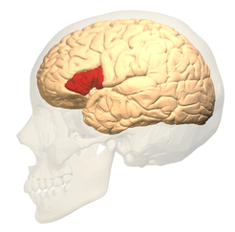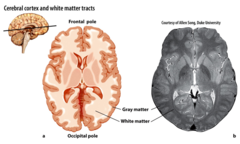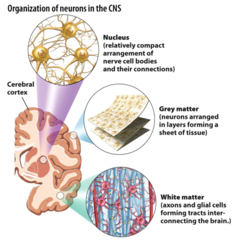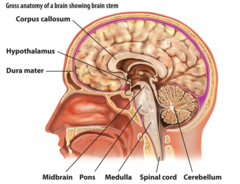![]()
![]()
![]()
Use LEFT and RIGHT arrow keys to navigate between flashcards;
Use UP and DOWN arrow keys to flip the card;
H to show hint;
A reads text to speech;
54 Cards in this Set
- Front
- Back
|
Thomas Willis |
Descriptive Studies - Early Anatomist, Surgeon - Sketched and described what he saw -> interested in identifying brain structures (e.g., Circle of Willis) - Created much of the brain nomenclature - Worked on vascular system |
|
|
Franz Joseph Gall |
Regional brain function - *Localization, identified individual brain areas visually - 35 distinct brain areas - ID of functional units - Specified brain regions |
|
|
Johann Spurzheim |
Regional brain function - Founder of Phrenology: not a real science - Phrenology: physical layout of the skull, larger brain = smarter - Accused of plagiarizing Gall |
|
|
Marie Jean Pierre Flourens |
Early Experimental Work: Lesion Studies -> causality - First to experimentally connect brain and behavior -> pigeons - Interestingly, did not support Darwin |
|
|
John Hughlings Jackson |
Epilepsy Observations: seizures were consistent and patterned; one part of brain could activate seizure - Concept: Topographical of Cortex |
|
|
Paul Broca |
Further support for Localization - Battlefield surgery experience - Brain damage specific impairment: can produce specific/certain deficits |
|
|
Brodmann Maps |
- 52 distinct areas: separated by patterns of the cells - Defined different regions of brain - #17: occipital cortex, primary visual cortex, “area 17” - Brodmann -> cut brain in fine slices and figured out patterns with clothing dye |
|
|
Camillo Golgi |
- Chemist (and good neuroscientist) that created silver impregnation, which filled entire neuron. Still widely used today. - Enabled identification of individual cell types - Golgi Stain *Being able to draw in this time was a very valuable skill* |
|
|
Ramon y Cajal |
- First to realize that neuronal communication was electrical and its direction of communication - Proposed Neuron Doctrine |
|
|
Neuron Doctrine |
Neurons are information carriers. The concept proposed by the great Spanish neuroanatomist Santiago Ramon y Cajal in the 19th century that the neuron is the fundamental unit of the nervous system, and that the nervous system is composed of billion of these units (neurons) connected to process information. |
|
|
Nucleus contains ____ ____. |
DNA information |
|
|
Terminal = ____ Information = ____ |
Terminal = Chemical Information = Electrical |
|
|
Myelin sheath |
- Predominantly protein - Purpose is insulation for the axon for the action potential. |
|
|
Gyrus = ____ Sulcus = ____ |
Gyrus = Outer fold Sulcus = Inner fold |
|
|
Large vessels are beneficial on the exterior of brain because the exterior needs ___ ____ ____. |
the most attention. |
|
|
Cerebral spinal fluid (CSF) starts from ____ ventricle. |
lateral |
|
|
Three reasons for presence of CSF |
Diffuses into brain: 1. Dissipating toxins, waste removal 2. Transmission of hormones: for developmental changes 3. Allows brain to float: slows down from brain coming into contact with skull (protection) |
|
|
Left Hemisphere: |
Language |
|
|
Cerebral Cortex (4 lobes) |
- Occipital lobe: vision = primary sense. Recognition in other modalities. - Temporal lobe: auditory cortex, deep in amygdala, hippocampus = memory - Parietal lobe: somatosensory = touch -> know where limbs are. Polysensory -> integration. - Frontal lobe: 33-35%. Motor cortex. Produce speech. Developed last -> front: executive function; delayed gratification; learning over time (“wisdom”) -> make better decisions. |
|
|
Importance of oxygen. |
Oxygen is needed for brain for metabolism. Oxygen -> metabolism -> activity |
|
|
Back part of eye |
Retina |
|
|
Stroop task |
- Color - Measures inhibition |
|
|
Morris water maze |
- Rat in a spherical bucket to find a platform before being pulled out. 1 ft deep, 8ft diameter. Rats are good at spatial memory. - Measures spatial memory. |
|
|
BOLD |
Blood Oxygen Level Dependence |
|
|
Integrative vision |
“binocular” - In humans and predators (beneficial) |
|
|
Gray matter: What is the stacking pattern referred as? |
the lamination of the cortex |
|
|
Vesicles |
Little orbs that hold neurotransmitters |
|
|
Ventricles produce ___. |
CSF |
|
|
Primary visual system |
Light... |
|
|
Cognitive Neuroscience |
- Functional properties: how these processes work and the brain areas/regions that support them over lifespan. - Identify how brain regions work: connecting brain and behavior. - Brain function -> brain regions. |
|
|
Evolutionary Perspective |
A theory based on Natural Selection (Darwin). Natural selection is a mechanism -> change over time -> evolution. *Misconception: not a willful change. It is actually just a coincidence due to environmental change. "Change" is due to selection pressure, which either goes away, remains, or something else. |
|
|
Thalamus |
Relay structure of the brain. - Sense of smell doesn't cross through. - Sense of smell is powerful reactor to retrieving memory. - Smell: defensive mechanism, survival. Response stronger the first time. - Rats can't physically vomit. |
|
|
Theory... |
... explains broad principles. |
|
|
Block Test |
Used with split-brain patients. Match orientation of blocks. - Wada test is taken before this test. |
|
|
Wada Test |
In the late 1950s, the dominant role of the left hemisphere in language was confirmed by employing the Wada test, pioneered by Juhn A. Wada and Theodore Rasmussen. Often used before elective surgery for the treatment of disorders such as epilepsy to determine in which hemisphere the speech center is located. Patient is given an injection of amobarbital into the carotid artery, producing a rapid and brief anesthesia of the ipsilateral hemisphere. Patient is engaged in a series of tests related to language and memory. The Wada test has consistently revealed a strong bias for language lateralization to the left hemisphere, because when the injection is to the left side, the patient's ability to speak or comprehend speech is disrupted for several minutes. |
|
|
Brainstem (3 main parts) |
1. Medulla (myelencephalon) 2. Pons and cerebellum (metencephalon) 3. Midbrain (mesencephalon) |
|
|
Medulla |
Brainstem's most caudal portion, continuous with spinal cord, essential for life |
|
|
Pons |
Latin for "bridge", main connection between brain and cerebellum |
|
|
Cerebellum |
"Small cerebrum" or "little brain", home to most of the brain's neurons. |
|
|
Midbrain |
Lies superior to pons and can be seen only in a medical view. It surrounds the cerebral aqueduct, which connects the 3rd and 4th ventricles. |
|
|
Occipital lobe |
Vision = primary sense. Recognition in other modalities. |
|
|
Temporal lobe |
Auditory cortex. Deep in amygdala. Hippocampus = memory. |
|
|
Parietal lobe |
Somatosensory = touch -> know where limbs are. Polysensory -> integration. |
|
|
Frontal lobe |
33-35%. Motor cortex. Produce speech. Developed last = front: executive function, delayed gratification, learning over time (“wisdom”) -> make better decisions |
|
|
Broca's area (picture) |

|
|
|
Horizontal section (Imaging) |

|
|
|
Coronal section (Anatomy) |

|
|
|
Sagittal section |

|
|
|
Gap Junctions |
Connected pores between one or more neurons, which allow charge to travel between them. - Rare and limited form of communication: if one neuron is excited then all neurons become excited. - Gap junctions in cardiovascular system |
|
|
Basic neuroanatomy: gray matter, white matter, nucleus |
Gray matter: neurons arranged in layers forming a sheet of tissue. White matter: axons and glial cells forming tracts interconnecting the brain. White matter = indicator of myelin -> insulator. Nucleus: compacted nerve cell bodies and their connections. "Collection of cell bodies." |
|
|
Cerebral Cortex |
Outer layer of brain |
|
|
Ventricles |
Chambers that contain CSF |
|
|
Both produce myelin. |
Schwann cells and Oligodendrocytes |
|
|
Hypothesis |
A testable statement leading to an experiment. Stating an outcome. |

